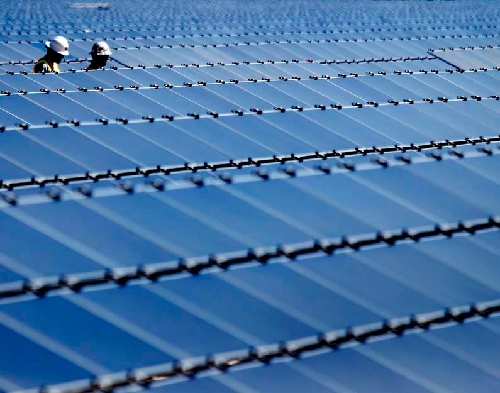Officials identify five prime Nevada areas for solar projects

WASHINGTON — The Obama administration on Thursday identified 17 sites in six Western states, including Nevada, as prime candidates for solar energy projects on public lands, continuing a push for solar power despite the high-profile bankruptcy of a solar panel maker that received a half-billion dollar federal loan.
Interior Secretary Ken Salazar said the latest “Solar Energy Zones” refine and improve on a draft released in December that identified 24 areas in California, Nevada, Colorado, Utah, New Mexico and Arizona.
Five sites in Nevada, four in Colorado, three in Utah, two each in California and Arizona, and one in New Mexico were identified as ideal for solar development.
The sites comprise 285,000 acres, down from about 677,000 acres in December, and reflect the department’s judgment that the targeted land has the highest potential for solar development with the fewest environmental conflicts. And though Salazar praised the latest solar-zone initiative as an advance for renewable development, industry experts said they were concerned about drastic cuts in acreage set aside for projects.
In Nevada, the department cut its list of targeted sites from seven to five, shedding the Delamar Valley zone 11 miles east of Alamo, and the East Mormon Mountain zone 13 miles northwest of Mesquite. The remaining five sites span the state from Hawthorne to northern Clark County.
Nevada has more acreage committed to solar development under the plan than any other state save California. While California has only two projects in the southeastern corner of the state, it has more than half the total acreage, with almost 154,000 acres. Nevada has 60,400 acres.
Officials didn’t specify in a Thursday conference call why they dropped the Delamar Valley and East Mormon Mountain zones, but said they cut sites that were smaller, didn’t generate much investor interest, weren’t close enough to transmission grids or had environmental issues.
The plan is intended to promote development of large, utility-scale solar projects that will generate thousands of megawatts of electricity while minimizing conflicts with wildlife, cultural and historic resources.
Salazar called the announcement a “giant step forward” as officials step up efforts to promote solar power, particularly in the West.
But solar-industry observers said Thursday they were concerned about the scale-back.
Dan Kammen, director of the Renewable and Appropriate Energy Laboratory at the University of California, Berkeley, said the Interior Department’s move was “essentially a setback” for solar development.
“The idea of the solar zones wasn’t that every single square mile of land was perfect for solar in terms of land, water availability and impact on communities. It was supposed to be a starting point,” Kammen said. “That they’re restricting those areas already is worrisome, because the goal right now is to scale up and facilitate renewable energy, not to start a program and immediately change the rules on it.”
Kammen said the United States has “incredible” renewable resources, but federal policy hasn’t progressed as quickly as industry experts expected when the Obama administration took office. That regulatory lag is hurting solar development’s appeal to investors in some cases.
“The biggest demand from the private sector is based on how enabling the policy conditions are,” Kammen said.
Rhone Resch, president and chief executive officer of the Washington-based Solar Energy Industries Association, said in a statement that Interior would “set the rules of the game for project development” over the next 20 years, and it’s imperative the agency gets it right.
“While we are still reviewing all of the details in this proposal, there are some significant areas of concern regarding the viability of a solar-energy zone approach,” Resch said. “Siting flexibility and access to transmission are key to the financing and development of utility-scale solar power plants. Both aspects must be reflected in the final (environmental-impact process).”
The administration’s push for renewable energy has come under attack since California-based Solyndra closed its doors two month ago after receiving a $528 million federal loan. The company declared bankruptcy and laid off its 1,100 workers.
The new plan, which is subject to a 90-day public comment period, “establishes for the first time a blueprint for landscape-level planning that will help facilitate smarter siting of solar energy projects,” Salazar said in a conference call with reporters
It also proposes to open an additional 20 million acres of public land to future solar development.
The department has 79 applications for solar projects on public lands pending and expects to approve as many as 14 next year, officials said.
Four public meetings on the plan are scheduled in November and December.
Washington Bureau Chief Steve Tetreault and Review-Journal staff writer Jennifer Robison contributed to this report. Contact Tetreault at stetreault@stephensmedia.com or 202-783-1760. Contact Robison at jrobison@reviewjournal.com or 702-380-4512.